2009 TOYOTA TUNDRA airbag
[x] Cancel search: airbagPage 128 of 672
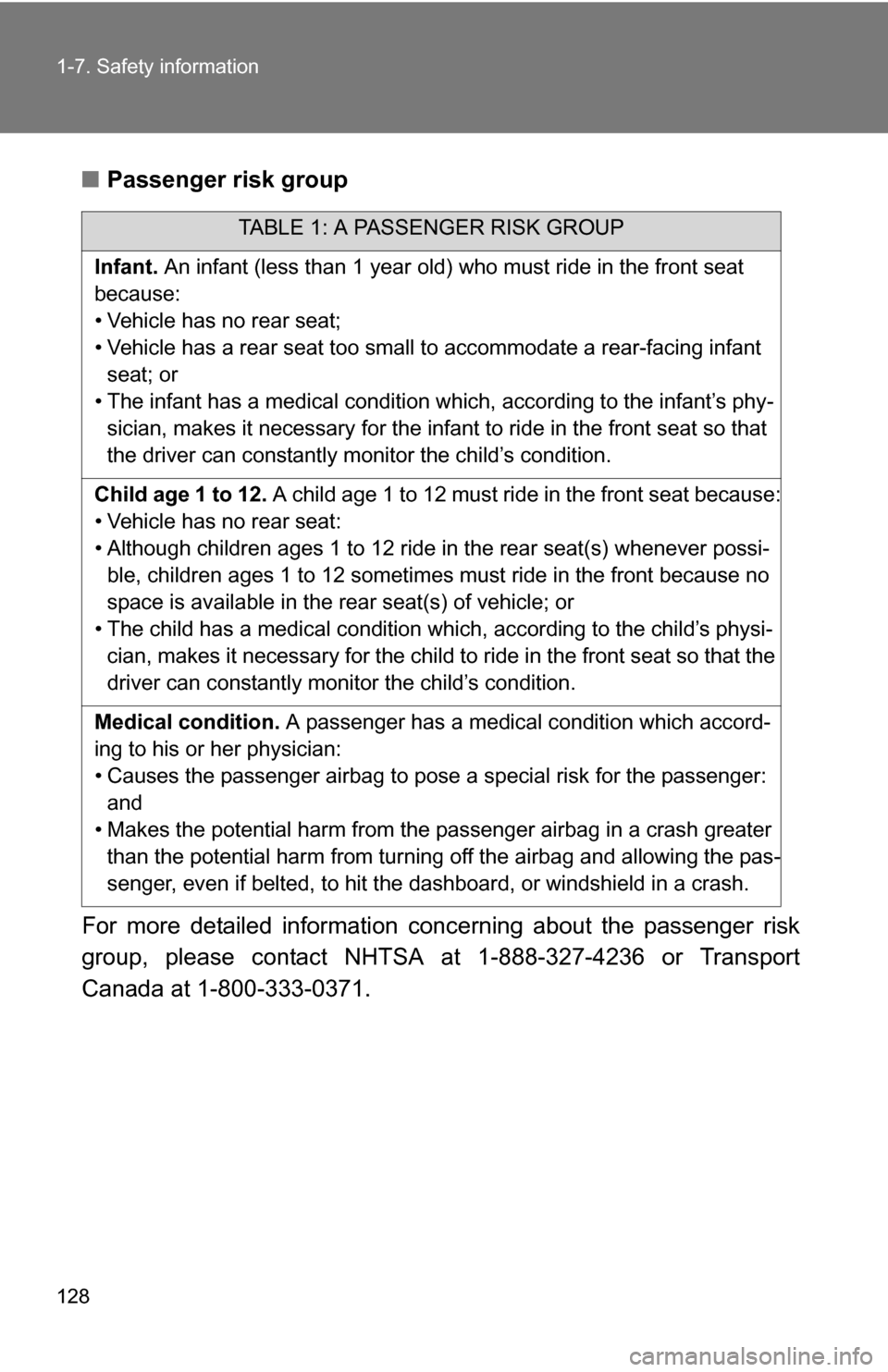
128 1-7. Safety information
■Passenger risk group
For more detailed information conc erning about the passenger risk
group, please contact NHTSA at 1-888-327-4236 or Transport
Canada at 1-800-333-0371.
TABLE 1: A PASSENGER RISK GROUP
Infant. An infant (less than 1 year old) who must ride in the front seat
because:
• Vehicle has no rear seat;
• Vehicle has a rear seat too small to accommodate a rear-facing infant seat; or
• The infant has a medical condition which, according to the infant’s phy- sician, makes it necessary for the infant to ride in the front seat so that
the driver can constantly monitor the child’s condition.
Child age 1 to 12. A child age 1 to 12 must ride in the front seat because:
• Vehicle has no rear seat:
• Although children ages 1 to 12 ride in the rear seat(s) whenever possi- ble, children ages 1 to 12 sometimes must ride in the front because no
space is available in the rear seat(s) of vehicle; or
• The child has a medical condition which, according to the child’s physi- cian, makes it necessary for the child to ride in the front seat so that\
the
driver can constantly monitor the child’s condition.
Medical condition. A passenger has a medical condition which accord-
ing to his or her physician:
• Causes the passenger airbag to pose a special risk for the passenger: and
• Makes the potential harm from the passenger airbag in a crash greater
than the potential harm from turning off the airbag and allowing the pas-
senger, even if belted, to hit the dashboard, or windshield in a crash.
Page 129 of 672
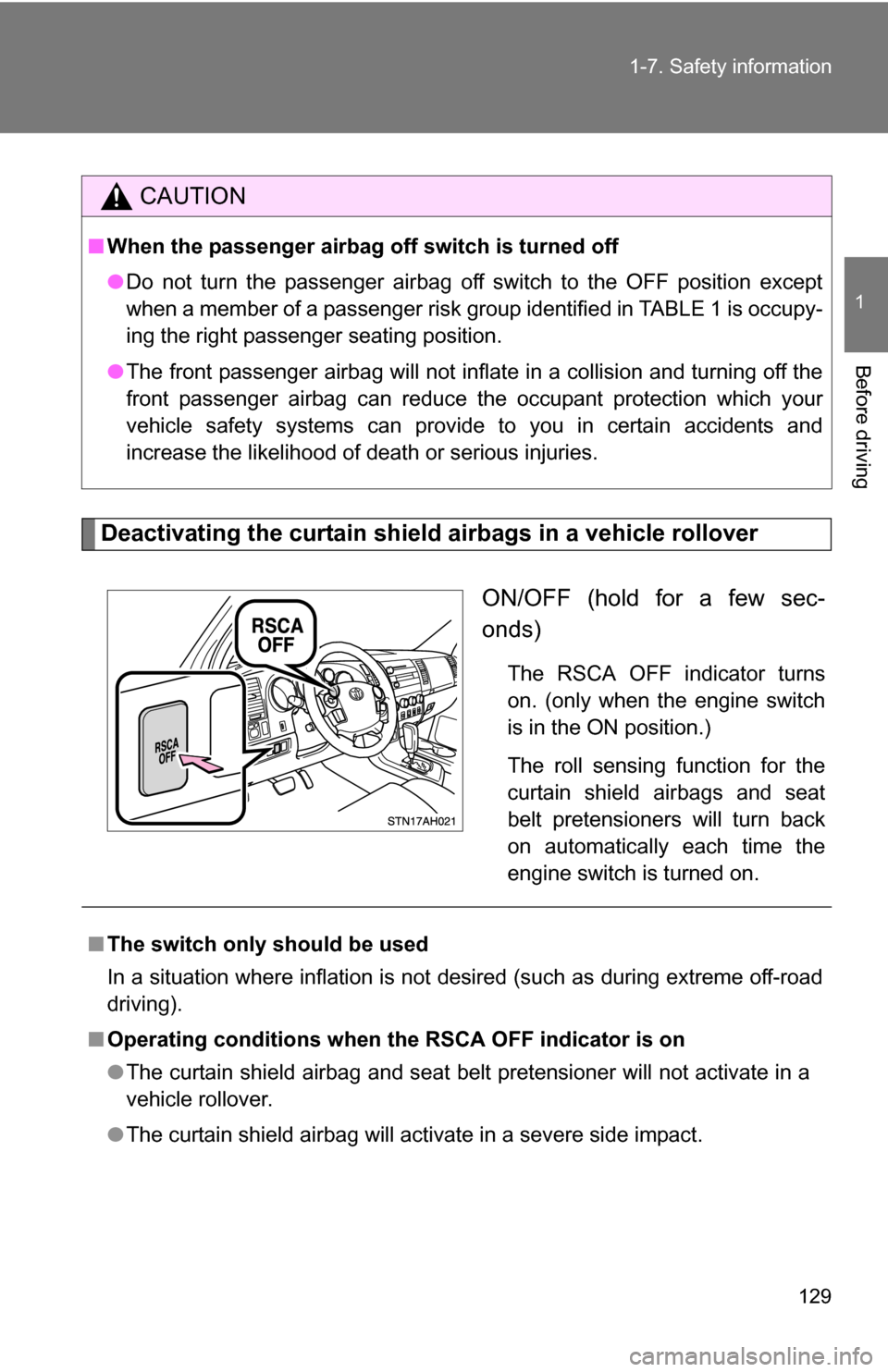
129
1-7. Safety information
1
Before driving
Deactivating the curtain shield airbags in a vehicle rollover
ON/OFF (hold for a few sec-
onds)
The RSCA OFF indicator turns
on. (only when the engine switch
is in the ON position.)
The roll sensing function for the
curtain shield airbags and seat
belt pretensioners will turn back
on automatically each time the
engine switch is turned on.
CAUTION
■When the passenger airbag of f switch is turned off
● Do not turn the passenger airbag off switch to the OFF position except
when a member of a passenger risk group identified in TABLE 1 is occupy-
ing the right passenger seating position.
● The front passenger airbag will not inflate in a collision and turning off the
front passenger airbag can reduce the occupant protection which your
vehicle safety systems can provide to you in certain accidents and
increase the likelihood of death or serious injuries.
■The switch only should be used
In a situation where inflation is not desired (such as during extreme off-road
driving).
■ Operating conditions when th e RSCA OFF indicator is on
● The curtain shield airbag and seat belt pretensioner will not activate in a
vehicle rollover.
● The curtain shield airbag will activate in a severe side impact.
Page 130 of 672
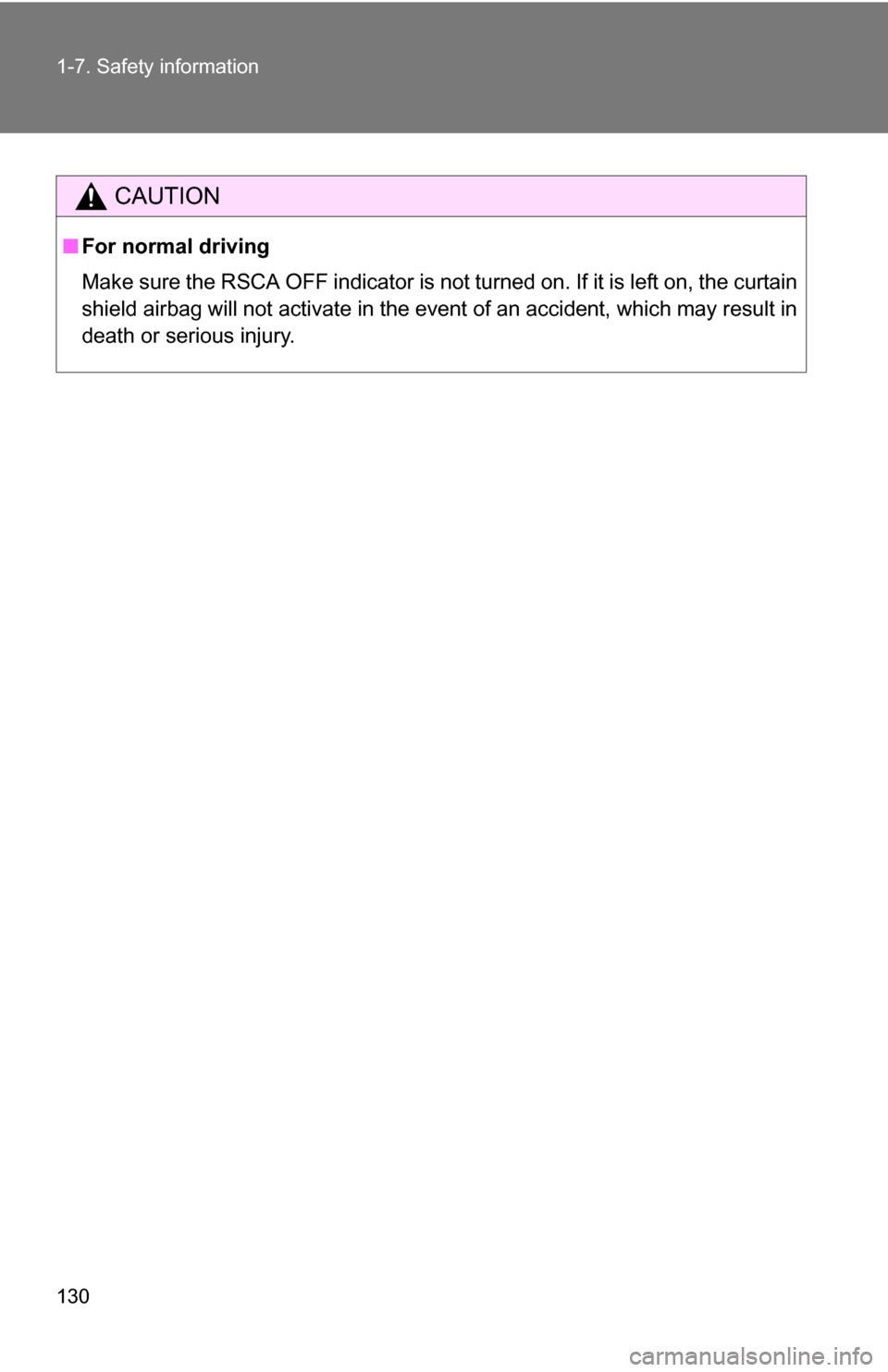
130 1-7. Safety information
CAUTION
■For normal driving
Make sure the RSCA OFF indicator is not turned on. If it is left on, the curtain
shield airbag will not activate in the event of an accident, which may result in
death or serious injury.
Page 132 of 672
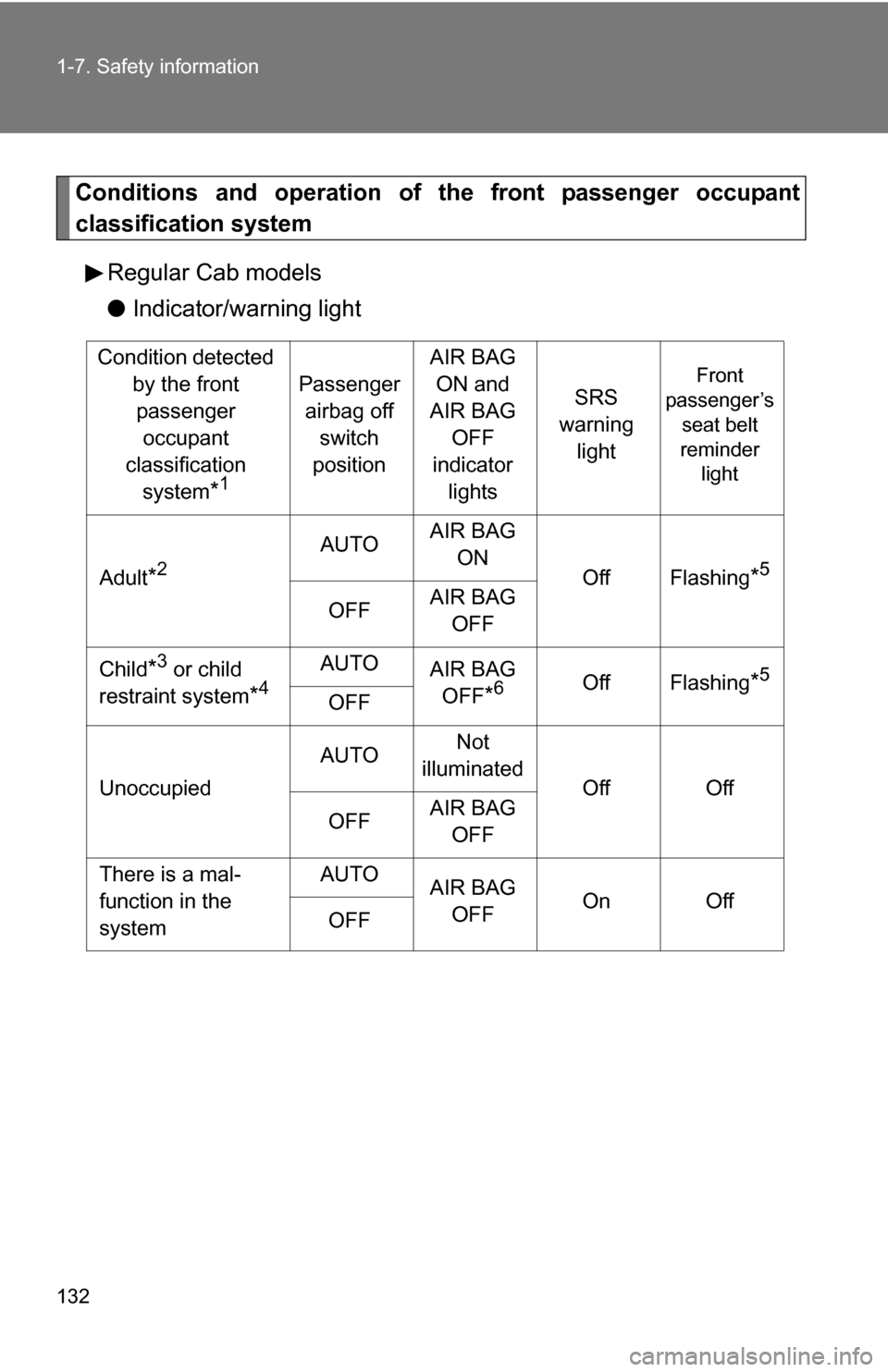
132 1-7. Safety information
Conditions and operation of the front passenger occupant
classification system
Regular Cab models
●Indicator/warning light
Condition detected
by the front passenger occupant
classification system
*1
Passenger airbag off switch
position
AIR BAG ON and
AIR BAG OFF
indicator lights
SRS
warning light
Front
passenger’s
seat belt
reminder light
Adult*2
AUTOAIR BAG
ON
OffFlashing*5
OFFAIR BAG OFF
Child*3 or child
restraint system
*4
AUTOAIR BAG OFF
*6OffFlashing*5
OFF
Unoccupied
AUTONot
illuminated
OffOff
OFFAIR BAG OFF
There is a mal-
function in the
systemAUTOAIR BAG OFFOnOffOFF
Page 135 of 672
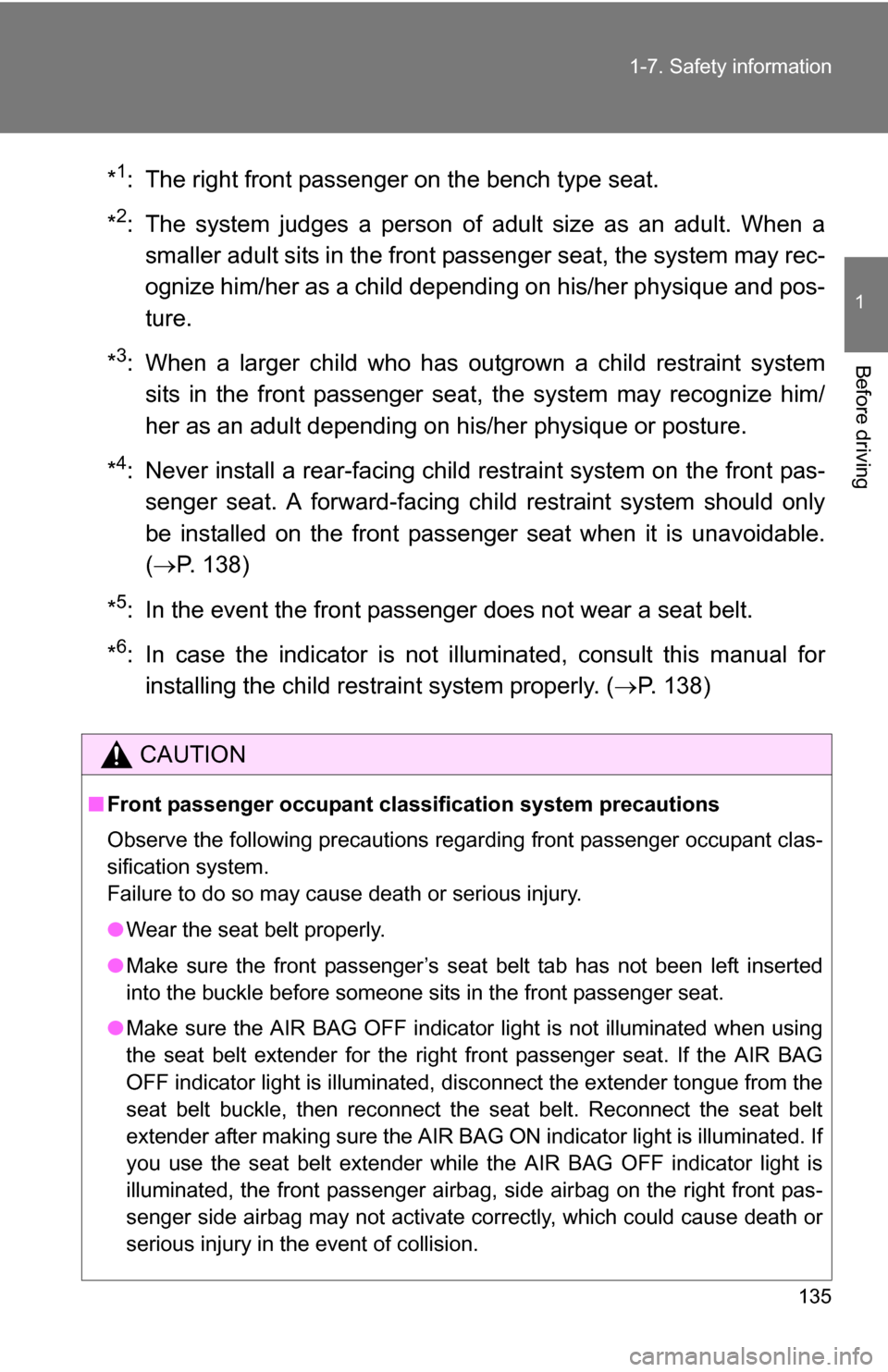
135
1-7. Safety information
1
Before driving
*1: The right front passenger on the bench type seat.
*
2: The system judges a person of adult size as an adult. When a smaller adult sits in the front passenger seat, the system may rec-
ognize him/her as a child depending on his/her physique and pos-
ture.
*
3: When a larger child who has outgrown a child restraint system sits in the front passenger seat, the system may recognize him/
her as an adult depending on his/her physique or posture.
*
4: Never install a rear-facing child restraint system on the front pas-
senger seat. A forward-facing ch ild restraint system should only
be installed on the front passenger seat when it is unavoidable.
( P. 138)
*
5: In the event the front passenger does not wear a seat belt.
*
6: In case the indicator is not illu minated, consult this manual for
installing the child restra int system properly. (P. 138)
CAUTION
■Front passenger occupant cl assification system precautions
Observe the following precautions regarding front passenger occupant clas-
sification system.
Failure to do so may cause death or serious injury.
● Wear the seat belt properly.
● Make sure the front passenger’s seat belt tab has not been left inserted
into the buckle before someone sits in the front passenger seat.
● Make sure the AIR BAG OFF indicator light is not illuminated when using
the seat belt extender for the right front passenger seat. If the AIR BAG
OFF indicator light is illuminated, disconnect the extender tongue from the
seat belt buckle, then reconnect the seat belt. Reconnect the seat belt
extender after making sure the AIR BAG ON indicator light is illuminated. If
you use the seat belt extender while the AIR BAG OFF indicator light is
illuminated, the front passenger airbag, side airbag on the right front pas-
senger side airbag may not activate correctly, which could cause death or
serious injury in the event of collision.
Page 136 of 672
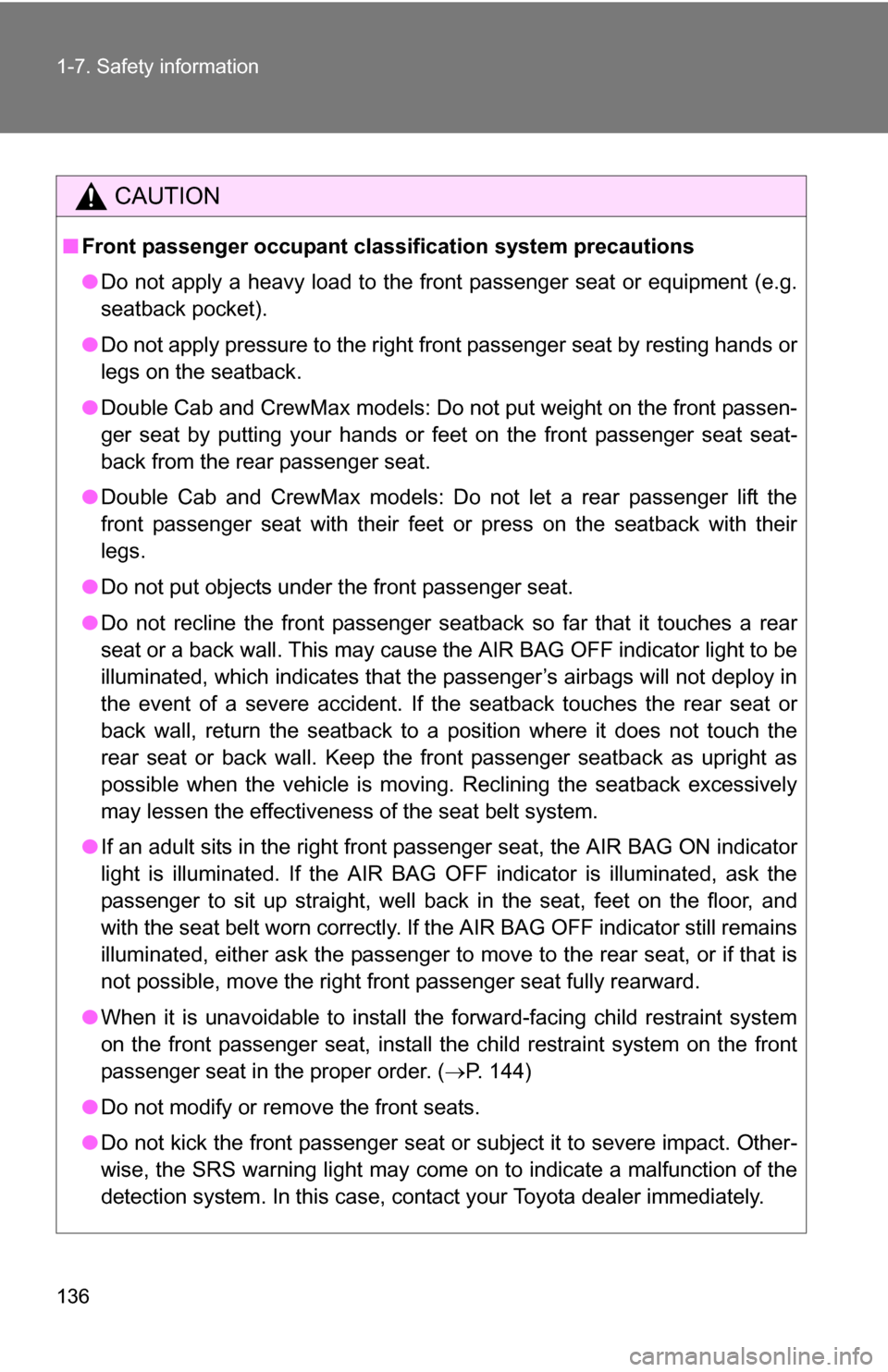
136 1-7. Safety information
CAUTION
■Front passenger occupant cl assification system precautions
● Do not apply a heavy load to the front passenger seat or equipment (e.g.
seatback pocket).
● Do not apply pressure to the right front passenger seat by resting hands or
legs on the seatback.
● Double Cab and CrewMax models: Do not put weight on the front passen-
ger seat by putting your hands or feet on the front passenger seat seat-
back from the rear passenger seat.
● Double Cab and CrewMax models: Do not let a rear passenger lift the
front passenger seat with their feet or press on the seatback with their
legs.
● Do not put objects under the front passenger seat.
● Do not recline the front passenger seatback so far that it touches a rear
seat or a back wall. This may cause the AIR BAG OFF indicator light to be
illuminated, which indicates that the passenger’s airbags will not deploy in
the event of a severe accident. If the seatback touches the rear seat or
back wall, return the seatback to a position where it does not touch the
rear seat or back wall. Keep the front passenger seatback as upright as
possible when the vehicle is moving. Reclining the seatback excessively
may lessen the effectiveness of the seat belt system.
● If an adult sits in the right front passenger seat, the AIR BAG ON indicator
light is illuminated. If the AIR BAG OFF indicator is illuminated, ask the
passenger to sit up straight, well back in the seat, feet on the floor, and
with the seat belt worn correctly. If the AIR BAG OFF indicator still remains
illuminated, either ask the passenger to move to the rear seat, or if that is
not possible, move the right front passenger seat fully rearward.
● When it is unavoidable to install the forward-facing child restraint system
on the front passenger seat, install the child restraint system on the front
passenger seat in the proper order. (P. 144)
● Do not modify or remove the front seats.
● Do not kick the front passenger seat or subject it to severe impact. Other-
wise, the SRS warning light may come on to indicate a malfunction of the
detection system. In this case, contact your Toyota dealer immediately.
Page 140 of 672
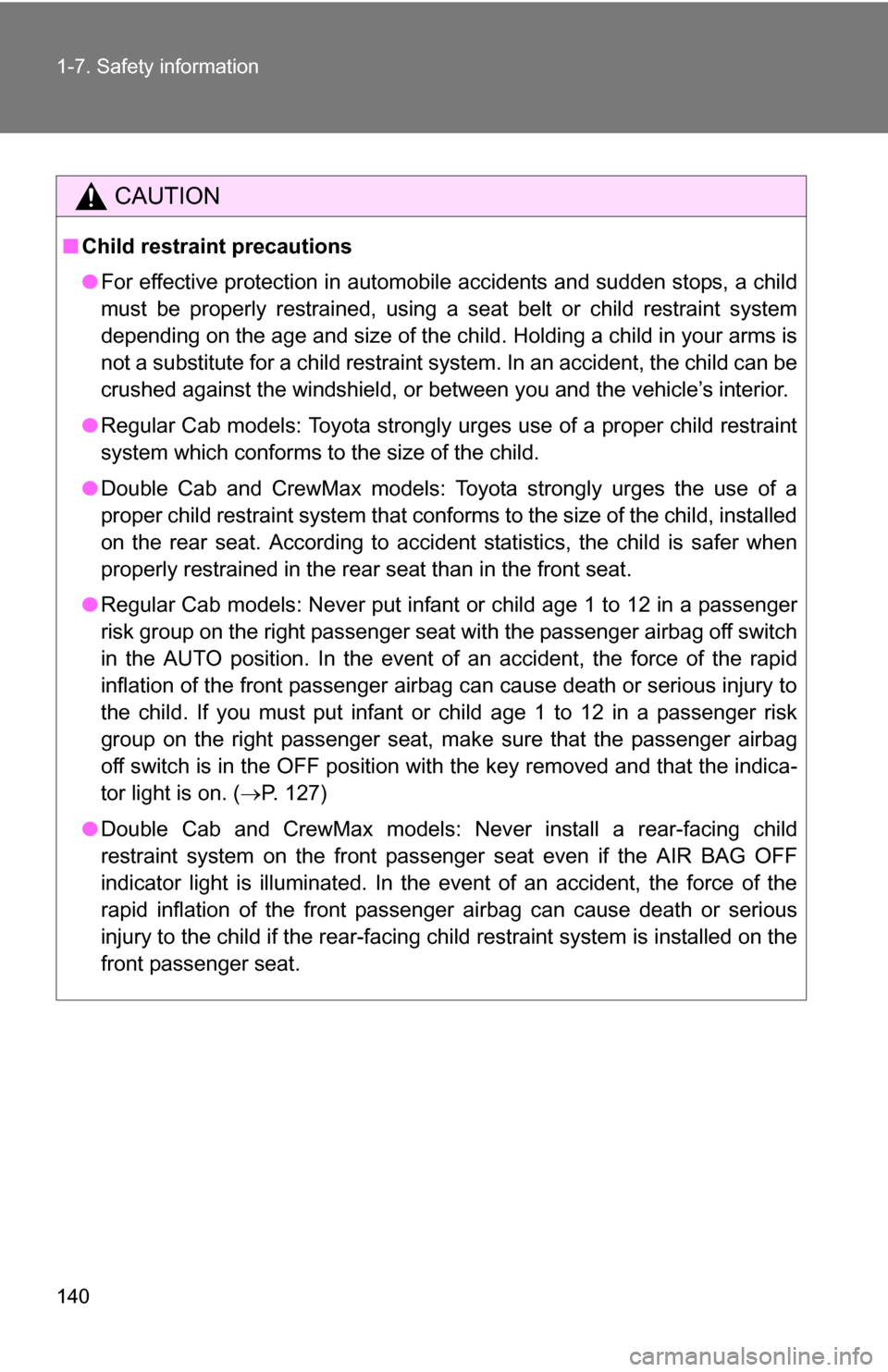
140 1-7. Safety information
CAUTION
■Child restraint precautions
●For effective protection in automobile accidents and sudden stops, a child
must be properly restrained, using a seat belt or child restraint system
depending on the age and size of the child. Holding a child in your arms is
not a substitute for a child restraint system. In an accident, the child can be
crushed against the windshield, or between you and the vehicle’s interior.
● Regular Cab models: Toyota strongly urges use of a proper child restraint
system which conforms to the size of the child.
● Double Cab and CrewMax models: Toyota strongly urges the use of a
proper child restraint system that conforms to the size of the child, installed
on the rear seat. According to accident statistics, the child is safer when
properly restrained in the rear seat than in the front seat.
● Regular Cab models: Never put infant or child age 1 to 12 in a passenger
risk group on the right passenger seat with the passenger airbag off switch
in the AUTO position. In the event of an accident, the force of the rapid
inflation of the front passenger airbag can cause death or serious injury to
the child. If you must put infant or child age 1 to 12 in a passenger risk
group on the right passenger seat, make sure that the passenger airbag
off switch is in the OFF position with the key removed and that the indica-
tor light is on. ( P. 127)
● Double Cab and CrewMax models: Ne ver install a rear-facing child
restraint system on the front passenger seat even if the AIR BAG OFF
indicator light is illuminated. In the event of an accident, the force of the
rapid inflation of the front passenger airbag can cause death or serious
injury to the child if the rear-facing child restraint system is installed on the
front passenger seat.
Page 141 of 672
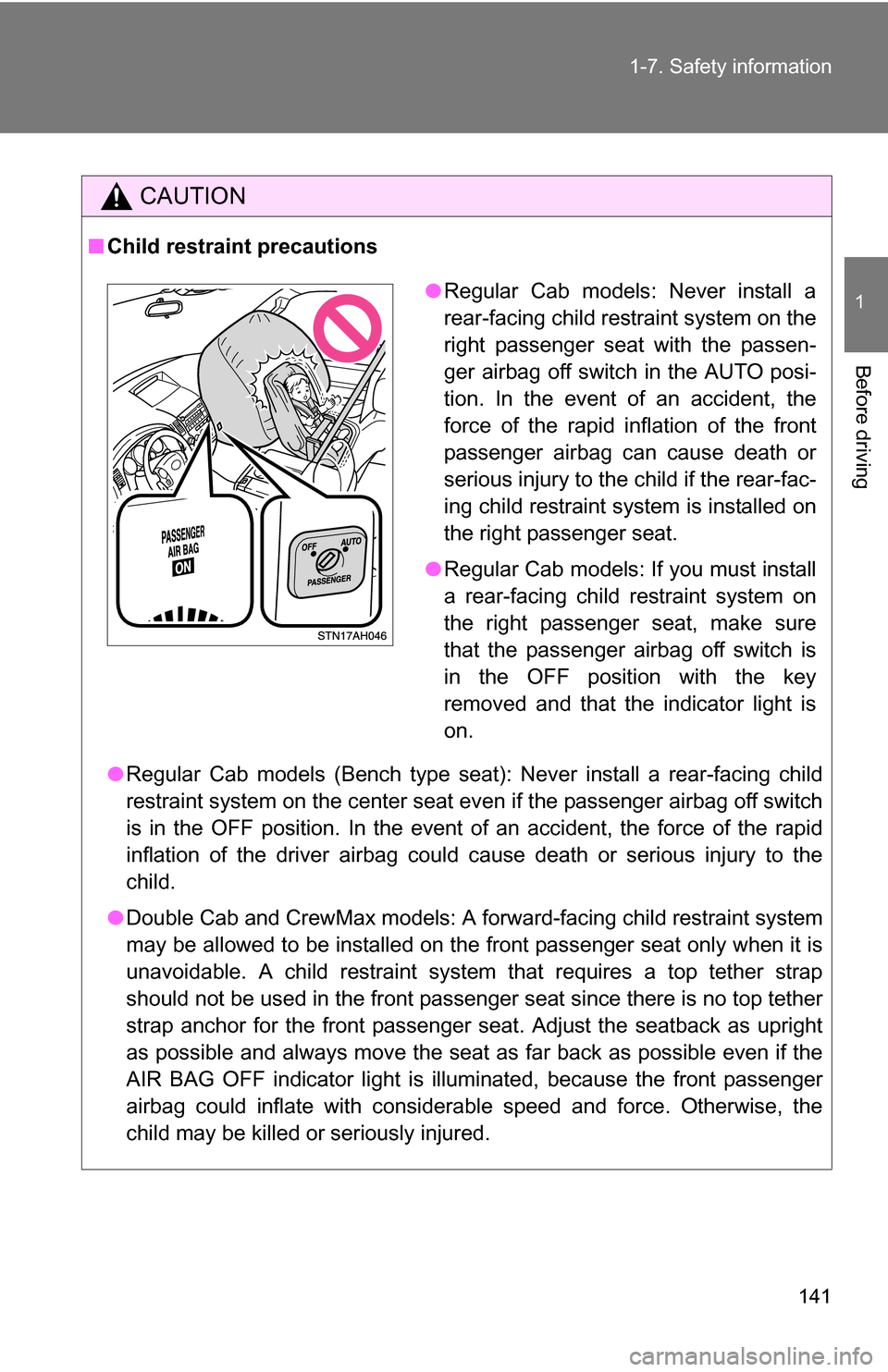
141
1-7. Safety information
1
Before driving
CAUTION
■
Child restraint precautions
●Regular Cab models (Bench type seat): Never install a rear-facing child
restraint system on the center seat even if the passenger airbag off switch
is in the OFF position. In the event of an accident, the force of the rapid
inflation of the driver airbag could cause death or serious injury to the
child.
● Double Cab and CrewMax models: A forward-facing child restraint system
may be allowed to be installed on the front passenger seat only when it is
unavoidable. A child restraint system that requires a top tether strap
should not be used in the front passenger seat since there is no top tether
strap anchor for the front passenger seat. Adjust the seatback as upright
as possible and always move the seat as far back as possible even if the
AIR BAG OFF indicator light is illuminated, because the front passenger
airbag could inflate with considerable speed and force. Otherwise, the
child may be killed or seriously injured.
●Regular Cab models: Never install a
rear-facing child restraint system on the
right passenger seat with the passen-
ger airbag off switch in the AUTO posi-
tion. In the event of an accident, the
force of the rapid inflation of the front
passenger airbag can cause death or
serious injury to the child if the rear-fac-
ing child restraint system is installed on
the right passenger seat.
● Regular Cab models: If you must install
a rear-facing child restraint system on
the right passenger seat, make sure
that the passenger airbag off switch is
in the OFF position with the key
removed and that the indicator light is
on.